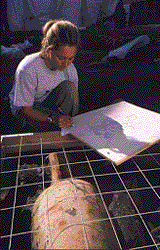

| |
| Conclusion |
"A Cache of Vintage Ships" Volume 52 Number 4, July/August 1999 |

Excavator draws an amphora. | Bruni expects the excavations to continue through this December, a year after the first ship surfaced. By then all of the vessels now known should have been excavated, encased in fiberglass, and moved to the conservation lab. But, and this is a big but, more vessels may be found--one is already known beneath ship D, and others may lie in layers so far untested--and this could prolong the excavation. Once in the lab, the ships' wood will be treated in preparation for eventual public display; the archaeological superintendency and the city government hope to build a special facility where people can view the ongoing restoration. The land around Pisa had marble quarries, according to Strabo, and grew high-quality grain; these products would have been shipped out of its harbors, much of it to Rome. Everything Pisa imported would also have passed through its harbors, from wine and olive oil to frankincense and myrrh. Bruni's work is admittedly in its early stages, and the results are preliminary. Nonetheless, useful details are emerging of trade up and down the west coast of Italy and of shipboard life, a picture that complements and tests what is known from historical sources. In the end, each boat will tell its own story--of a voyage to Pozzuoli to pick up construction materials, of a quick jaunt to Elba long before Napoleon's exile, of a sailor at loose ends carving his mark in the timbers of his ship. |
Andrew L. Slayman is a senior editor of ARCHAEOLOGY.
Introduction | Ship A | Ship B | Ship C | Ship D | Other Ships | A New Museum?
© 1999 by the Archaeological Institute of America archive.archaeology.org/9907/etc/concl.html |
Advertisement

Advertisement






